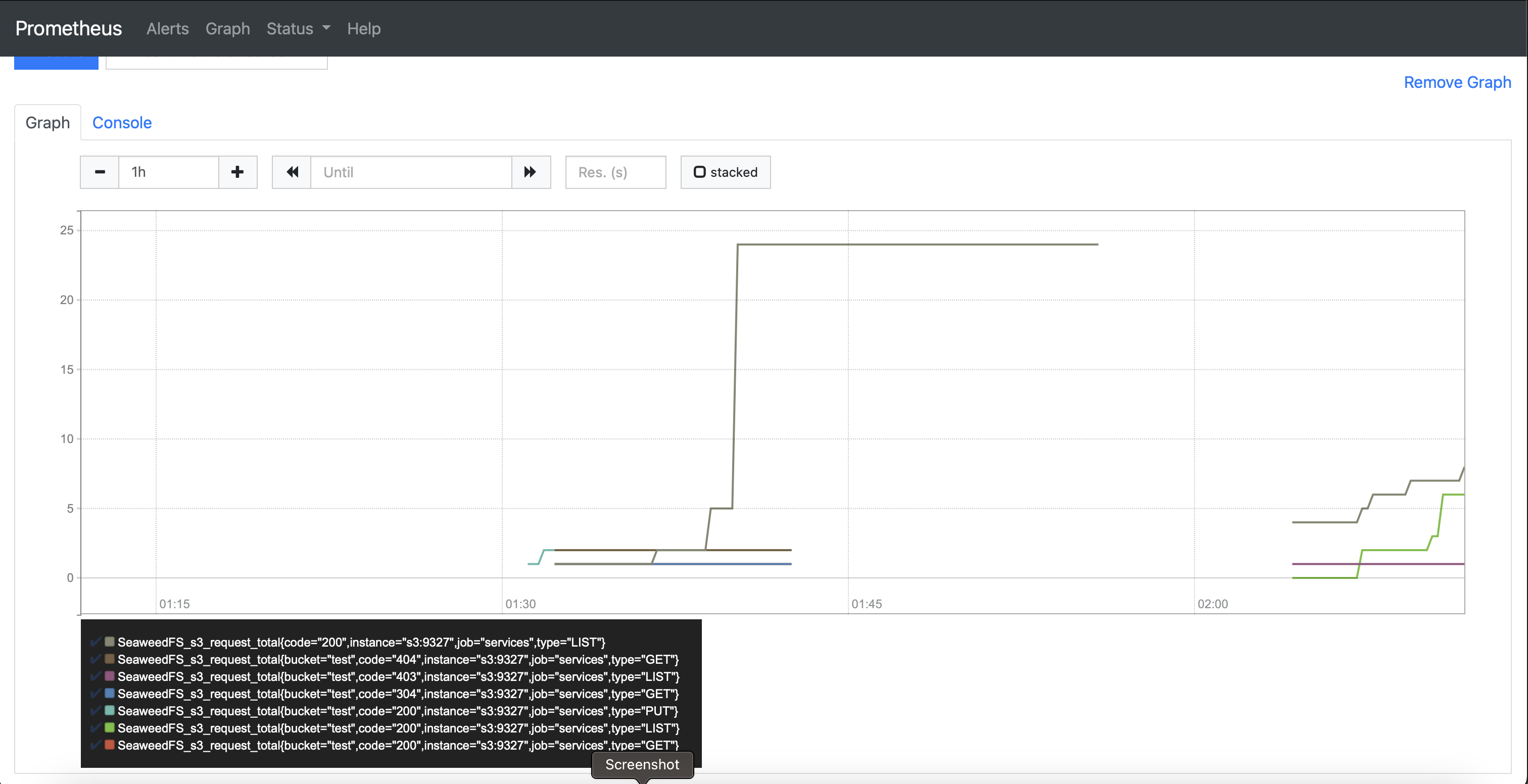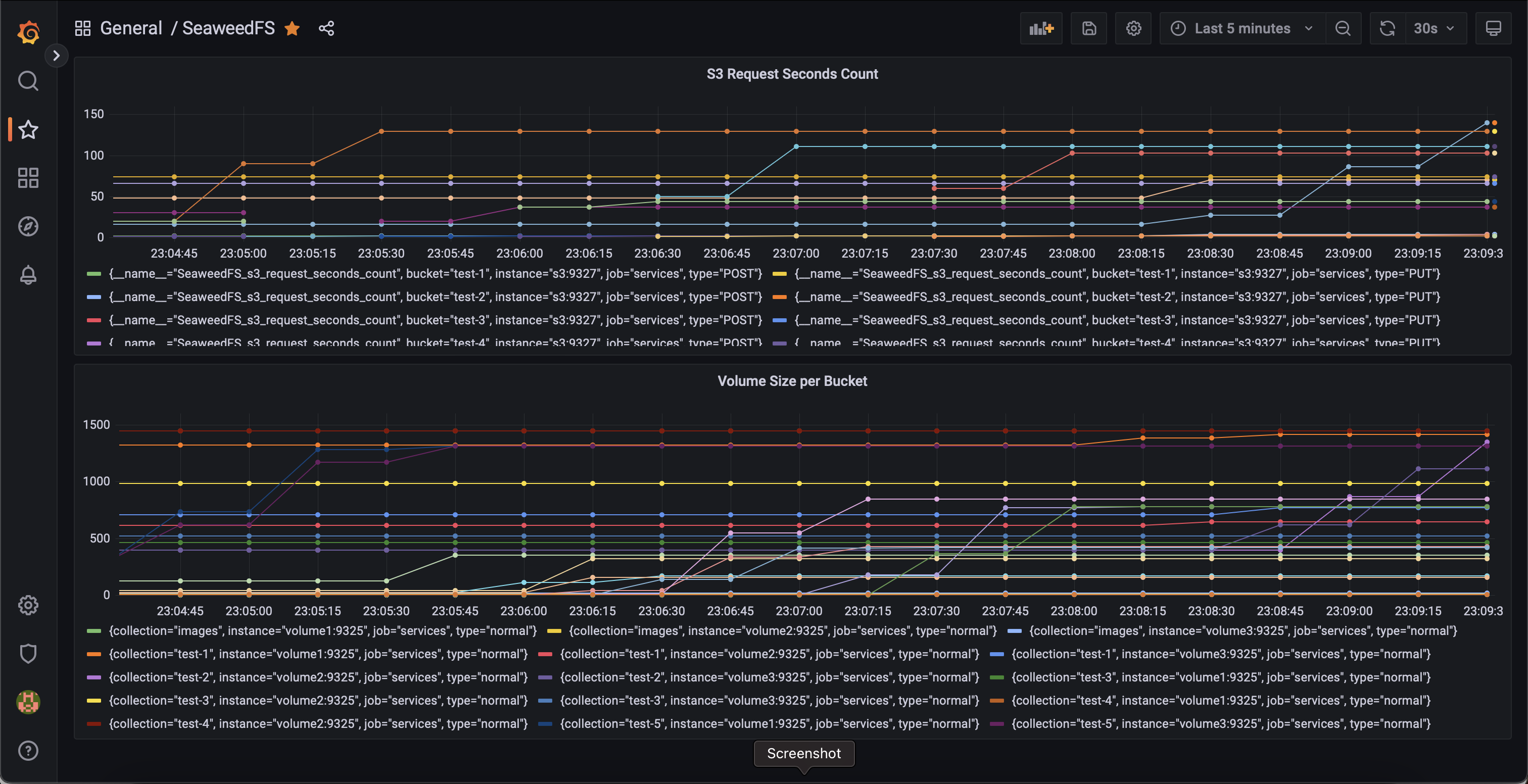Experimenting with SeaweedFS
I ran it locally on a MacOS with docker desktop
First Pass
Launch the server:
docker run --rm -p 8333:8333 chrislusf/seaweedfs server -s3
Commands:
aws s3 mb s3://test/ --endpoint-url http://localhost:8333 --no-sign-request
echo "This is a test" > ./test.txt
aws s3 cp ./test.txt s3://test/folder/test.txt --endpoint-url http://localhost:8333 --no-sign-request
Using any browser, you can get your file at http://localhost:8333/test/folder/test.txt
curl http://localhost:8333/test/folder/test.txt
Second Pass
Using docker-compose.yml provided from the seaweedfs repository, https://github.com/seaweedfs/seaweedfs/blob/master/docker/seaweedfs-compose.yml
I’ve updated it a bit: https://webuxlab.com/content/devops/seaweedfs/docker-compose.yml,
The other configurations:
- https://webuxlab.com/content/devops/seaweedfs/s3.json
- https://webuxlab.com/content/devops/seaweedfs/fluent.json
- https://webuxlab.com/content/devops/seaweedfs/prometheus/prometheus.yml
docker compose up
Check the cluster status:
curl "http://localhost:9333/cluster/status?pretty=y"
curl "http://localhost:9333/dir/status?pretty=y"
curl "http://localhost:9333/vol/status?pretty=y"
Testing with S3
See commands above for testing (Transfering files and etc.).
The configuration : https://github.com/seaweedfs/seaweedfs/wiki/Amazon-S3-API Presigned URL : https://github.com/seaweedfs/seaweedfs/wiki/AWS-CLI-with-SeaweedFS#presigned-url Development with NodeJS and S3 : https://github.com/seaweedfs/seaweedfs/wiki/nodejs-with-Seaweed-S3 The Commands: https://github.com/seaweedfs/seaweedfs/wiki/AWS-CLI-with-SeaweedFS
Once using the Default credentials, you can set the keys to send the commands:
export AWS_ACCESS_KEY_ID=some_access_key1
export AWS_SECRET_ACCESS_KEY=some_secret_key1
aws --endpoint-url http://localhost:8333 s3 ls
aws --endpoint-url http://localhost:8333 s3 ls s3://test
aws --endpoint-url http://localhost:8333 s3 mb s3://test-1
aws --endpoint-url http://localhost:8333 s3 mb s3://test-2
aws --endpoint-url http://localhost:8333 s3 mb s3://test-3
aws --endpoint-url http://localhost:8333 s3 mb s3://test-4
aws --endpoint-url http://localhost:8333 s3 mb s3://test-5
aws --endpoint-url http://localhost:8333 s3 mb s3://test-6
aws --endpoint-url http://localhost:8333 s3 mb s3://test-7
aws --endpoint-url http://localhost:8333 s3 mb s3://test-8
aws --endpoint-url http://localhost:8333 s3 mb s3://test-9
Filer
You can navigate the buckets from your browser at localhost:8888

Prometheus
Query Example: http://localhost:9000/graph?g0.range_input=1h&g0.expr=SeaweedFS_s3_request_total&g0.tab=0

Fun with bash
export AWS_ACCESS_KEY_ID=some_access_key1
export AWS_SECRET_ACCESS_KEY=some_secret_key1
mkdir -p /tmp/dummy
pushd /tmp/dummy
for (( a=1; a<=9; a++ ))
do
mkdir -p d$a
for (( c=1; c<=10; c++ ))
do
echo "Hi, $(( $RANDOM % 50 + 1 ))" >> d$a/dummy_${c}_xyz.log
done
r=$(( $RANDOM % 1000 + 1 ))
dd if=/dev/urandom of=d$a/data.bin bs=${r}M count=1
echo "File generated..."
aws --endpoint-url http://localhost:8333 s3 cp ./d$a/ s3://test-$a/ --recursive --exclude "*" --include "*.bin" --include "*_xyz.log"
done
popd
rm -rf /tmp/dummy/
Grafana
